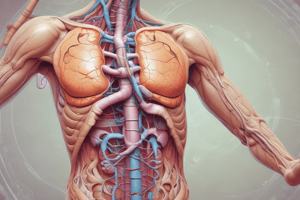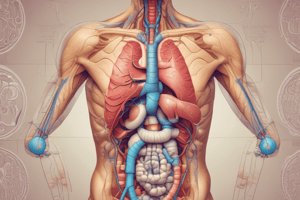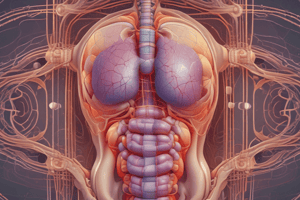Podcast
Questions and Answers
What is the primary function of lymphatic vessels in the tract?
What is the primary function of lymphatic vessels in the tract?
- To innervate the GI tract with autonomic motor and sensory fibres
- To secrete electrolytes and proteins into the oral cavity
- To aid in the intestinal absorption of dietary fat (correct)
- To regulate the endocrine control of the GI tract
What is the main function of saliva in the digestive process?
What is the main function of saliva in the digestive process?
- To aid in the digestion of proteins
- To regulate the pH of the stomach
- To lubricate food for swallowing and aid in starch digestion (correct)
- To stimulate the secretion of gastric acid
What is the outermost layer of the histological organisation of the digestive tract?
What is the outermost layer of the histological organisation of the digestive tract?
- Submucosa
- Muscularis externa
- Adventitia/Serosa (correct)
- Mucosa
What type of fibres are present in the GI tract?
What type of fibres are present in the GI tract?
Where are endocrine cells widely distributed in the GI tract?
Where are endocrine cells widely distributed in the GI tract?
What are the two phases of gastric acid secretion?
What are the two phases of gastric acid secretion?
What is the structure that increases in size in an activated parietal cell?
What is the structure that increases in size in an activated parietal cell?
What is the significance of vascular and lymphatic vessels in the GI tract?
What is the significance of vascular and lymphatic vessels in the GI tract?
Which of the following neurotransmitters is released at or near the basolateral surface of parietal cells?
Which of the following neurotransmitters is released at or near the basolateral surface of parietal cells?
What is the mechanism by which histamine reaches the parietal cells?
What is the mechanism by which histamine reaches the parietal cells?
Which of the following statements is true about gastrin?
Which of the following statements is true about gastrin?
What is the target of proton pump inhibitors like omeprazole?
What is the target of proton pump inhibitors like omeprazole?
What is the mechanism by which gastrin reaches the parietal cells?
What is the mechanism by which gastrin reaches the parietal cells?
What is the function of D cells?
What is the function of D cells?
Which of the following statements regarding the digestion of carbohydrates is incorrect?
Which of the following statements regarding the digestion of carbohydrates is incorrect?
What is the primary function of the muscular valves or sphincters that separate the organs of the digestive tract?
What is the primary function of the muscular valves or sphincters that separate the organs of the digestive tract?
Which of the following layers of the gastrointestinal tract is directly responsible for the lining of the inner surface of the digestive tract?
Which of the following layers of the gastrointestinal tract is directly responsible for the lining of the inner surface of the digestive tract?
What is the primary function of bile salts secreted by the liver?
What is the primary function of bile salts secreted by the liver?
What is the correct sequence of the major organs in the digestive tract, starting from the mouth?
What is the correct sequence of the major organs in the digestive tract, starting from the mouth?
Which of the following is NOT a function of the endocrine control of the gastrointestinal tract?
Which of the following is NOT a function of the endocrine control of the gastrointestinal tract?
Which of the following is NOT a feature common to all four major organs of the digestive tract after the mouth?
Which of the following is NOT a feature common to all four major organs of the digestive tract after the mouth?
Which of the following statements regarding the enterohepatic circulation is correct?
Which of the following statements regarding the enterohepatic circulation is correct?
What is the main characteristic of pancreatic juice in terms of its protein synthesis rate?
What is the main characteristic of pancreatic juice in terms of its protein synthesis rate?
Which component of pancreatic juice is responsible for neutralizing duodenal content?
Which component of pancreatic juice is responsible for neutralizing duodenal content?
Which of the following is NOT a proteolytic enzyme found in pancreatic juice?
Which of the following is NOT a proteolytic enzyme found in pancreatic juice?
What role do bile salts play in digestion?
What role do bile salts play in digestion?
Which enzyme in pancreatic juice is specifically responsible for hydrolyzing neutral fats?
Which enzyme in pancreatic juice is specifically responsible for hydrolyzing neutral fats?
Which regulatory mechanism is NOT involved in the digestion and absorption of dietary nutrients?
Which regulatory mechanism is NOT involved in the digestion and absorption of dietary nutrients?
Study Notes
Overview of the Digestive System
- GI tract consists of serosa, muscularis externa, submucosa, and mucosa, each layer having distinct functions.
- Comprises four main organs: esophagus, stomach, small intestine, and large intestine, separated by sphincters.
- Carbohydrate digestion begins in the mouth via amylase; most digestion and absorption occurs in the stomach and small intestine.
- Exocrine products such as bicarbonate from pancreas and bile salts from liver are crucial for digestion in the small intestine.
- Lymphatic vessels aid in the absorption of dietary fats throughout the GI tract.
Salivary Secretions
- Salivary glands release electrolytes and proteins, including amylase, to aid food lubrication and starch digestion.
- Saliva consists of glycoproteins from submandibular and sublingual glands, facilitating swallows.
Histological Organization and Functionality
- Four layers of the digestive tract: mucosa, submucosa, muscularis externa, and adventitia/serosa, with distinct roles in digestion.
- Vascular and lymphatic networks support nutrient supply and the removal of waste.
- Autonomic nervous system fibers control both motor and sensory functions within the GI tract.
- Endocrine regulation involves gut hormones affecting digestion through neurocrine, paracrine, and endocrine mechanisms, distributed across GI epithelium.
Gastric Acid Secretion Phases
- Gastric acid secretion occurs in two phases: basal (fasting) and stimulated (post-prandial), subdivided into cephalic, gastric, and intestinal phases.
Regulation of Acid Secretion in Parietal Cells
- Acid secretion regulated by acetylcholine, histamine, and gastrin, termed Soll's three receptor hypothesis.
- ACh, gastrin, and histamine are involved in different regulatory mechanisms (neurocrine, endocrine, paracrine) affecting parietal cells.
- G cells secrete gastrin into circulation, stimulating acid secretion through interactions with parietal cells.
Pancreatic Juice Secretion
- The pancreas has a high protein synthesis rate, except for lactating mammary glands.
- Aqueous component contains bicarbonate to neutralize acidic chyme entering the duodenum.
- Enzyme components include proteolytic enzymes like trypsinogen, chymotrypsinogen, amylase, and lipase for nutrient breakdown.
Digestion and Nutrient Absorption
- Carbohydrates, amino acids, and oligopeptides undergo breakdown and absorption through specialized mechanisms.
- Bile salts play a critical role in dietary fat absorption, influencing emulsification and micelle formation.
- Digestion and absorption processes are regulated through multiple stimulatory and inhibitory pathways involving hormones.
Studying That Suits You
Use AI to generate personalized quizzes and flashcards to suit your learning preferences.
Related Documents
Description
Quiz based on lectures for MBBS Year 1 students, covering the digestive system, secretions, digestion, and absorption of nutrients, motility, and biliary system. References from Physiology textbooks by Berne, Levy, Koeppen, and Stanton, and Boron and Boulpaep.




